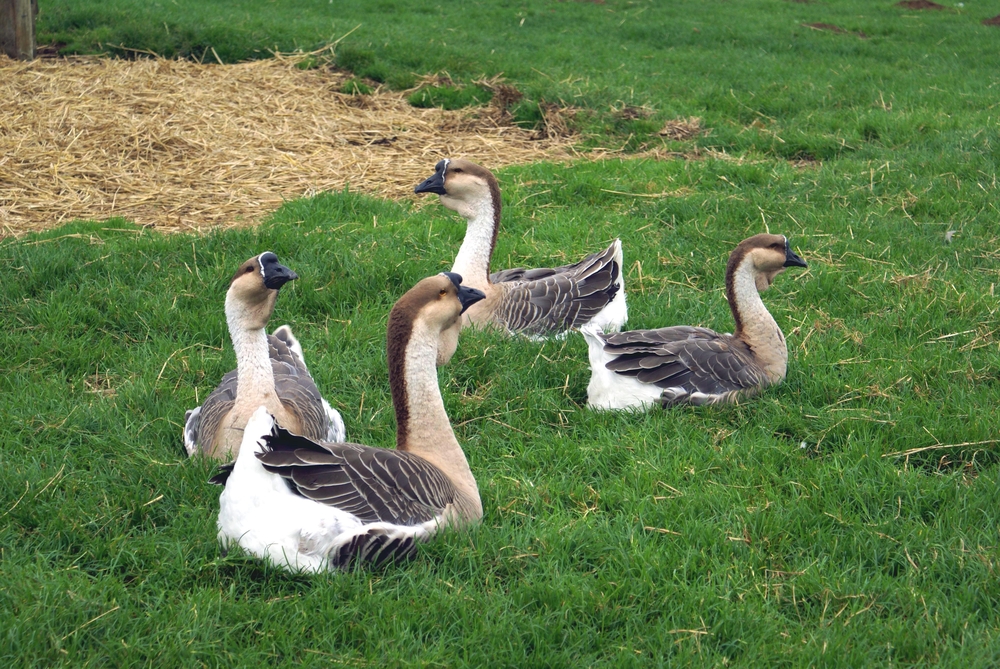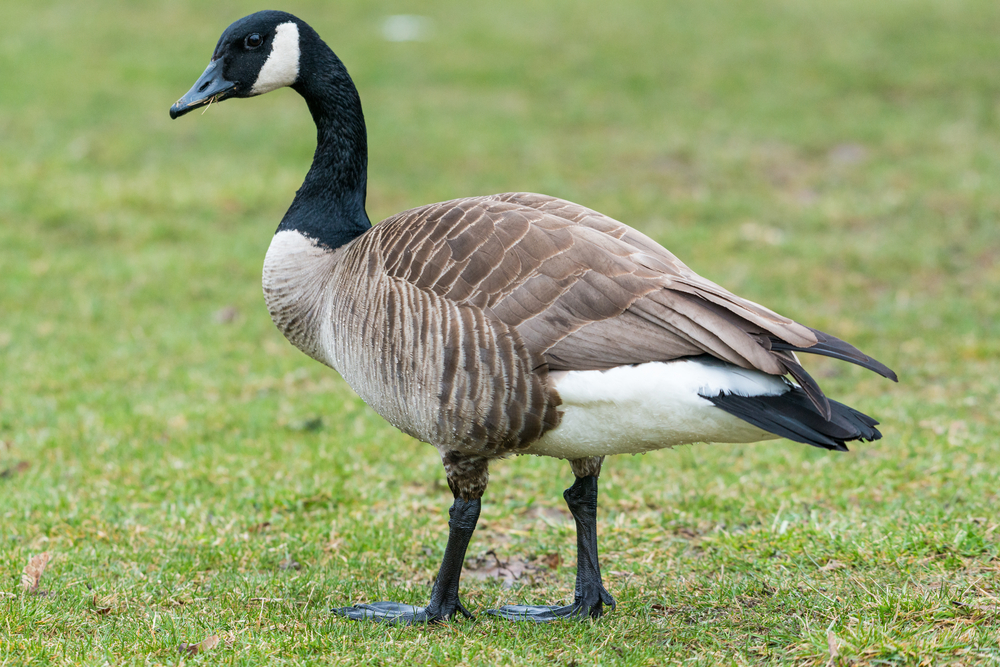The African Goose is a domesticated form of the Swan Goose (Anser cygnoides), native to Asia. Its closest relatives include the Chinese Goose, which also descends from the Swan Goose but is typically lighter and more slender in build.
About
The African Goose (Anser cygnoides domesticus) is a large domestic goose breed belonging to the Anatidae family, which includes ducks, swans, and geese. Despite its name, the African Goose did not originate in Africa but is descended from the wild Swan Goose (Anser cygnoides) of Asia. It is closely related to the Chinese Goose, with which it shares similar ancestry, though the African variety is heavier, stockier, and bred primarily for meat production.
African Geese are impressive in size, with ganders weighing 10 to 12 kilograms (22 to 26 pounds) and females around 8 to 10 kilograms (18 to 22 pounds). Their most distinctive feature is the prominent knob at the base of the bill, more pronounced in males. They come in two main color varieties: brown (similar to the wild Swan Goose) and white. The brown form has a dark brown stripe running from the crown down the back of the neck, contrasting with lighter buff plumage, while the white form is pure snowy white with orange legs and bill.
This breed is known for its gentle temperament, although it can be loud and protective, making it both a farmyard guardian and a companion animal. They are excellent grazers, feeding on grasses, grains, and leafy plants, and are often kept to manage weeds in pastures and orchards.
African Geese are reliable layers compared to other heavy goose breeds, producing 20 to 40 large white eggs per season. They are also valued for their rapid growth and flavorful meat. With proper care, these geese can live 15 to 20 years, making them a long-term addition to farms and homesteads.
Highly regarded for their beauty, productivity, and versatility, African Geese remain a popular choice for poultry keepers around the world.
Physical Characteristics
The African Goose is a large, heavy-bodied domestic goose breed derived from the Swan Goose, notable for its imposing size and distinct knob at the base of the bill.
Plumage: African Geese are commonly found in two main color varieties: brown and white. The brown form has a dark brown crown, buffy neck, and gray-brown body with lighter underparts, while the white form is pure white with orange bill and legs. Both varieties display a dark vertical stripe running down the back of the neck.
Head & Beak: The most distinctive feature is the large black knob at the base of the bill, more pronounced in males. The beak is broad and strong, colored black in the brown variety and orange in the white variety. Eyes are dark brown, giving a bold expression.
Body & Neck: The body is massive and deep-breasted, with a proud, upright stance. The long, arching neck curves gracefully and is marked by a contrasting stripe. The legs and feet are sturdy, orange in color, supporting their heavy frame.
Size:
-
Length (Body and Tail): 30–36 in (76–91 cm)
-
Wingspan: 4.5–5.5 ft (1.4–1.7 m)
-
Neck Length: 12–15 in (30–38 cm)
Weight:
-
Adult Male (Gander): 18–22 lbs (8–10 kg)
-
Adult Female (Goose): 14–18 lbs (6–8 kg)
The African Goose’s heavy body, upright carriage, and signature basal knob distinguish it from other domestic goose breeds, making it both a utility bird for meat and a show bird admired for its unique appearance.
Reproduction
The reproductive cycle of the African Goose reflects its domesticated background, with selective breeding enhancing egg production and brood care.
1. Mating and Courtship:
African Geese are generally monogamous and form strong pair bonds. Courtship includes head-dipping, honking displays, and following behavior, with males often guarding their mates.
2. Breeding Season:
In temperate climates, the breeding season begins in late winter to spring (February–April), though in captivity, with good care, they may breed over a longer season.
3. Nesting:
The female builds a nest of grass, straw, and down plucked from her own breast. Nests are typically located in sheltered areas on the ground, and domestic flocks may use provided nest boxes.
4. Egg Laying and Incubation:
A typical clutch contains 10–15 large white eggs. The female incubates the eggs for 28–35 days, while the gander guards the territory and may act aggressively to deter threats.
5. Hatching and Gosling Development:
Goslings hatch with yellow down, weighing about 3–4 oz (85–110 g). They are precocial, leaving the nest within a day to follow the mother. Both parents guard them, though the female is the primary caregiver.
6. Growth and Fledging:
Goslings grow rapidly, feathering out by 8–10 weeks, and are fully independent by 12–14 weeks. Domestic strains have been selected for fast growth and meat production.
7. Sexual Maturity:
African Geese reach breeding maturity at about 2 years of age, though some may breed earlier under managed conditions.
The African Goose’s strong parental instincts, combined with selective breeding for large clutch size and rapid growth, make it a productive and reliable domestic waterfowl breed.
Lifespan
The African Goose is a hardy and long-lived domestic breed, with longevity influenced by care, diet, and management practices.
Lifespan in the Wild (Ancestral Species):
The Swan Goose (Anser cygnoides), from which the African Goose was derived, typically lives 10–15 years in natural conditions, though wild populations face predation and habitat pressures.
Lifespan in Domestication:
Under good care, African Geese can live 15–20 years, and in some cases longer. With balanced nutrition, safe housing, and protection from predators, they may reach up to 25 years.
Threats to the African Goose:
-
Predation: Domestic geese remain vulnerable to foxes, coyotes, raptors, and stray dogs if not properly protected.
-
Health Issues: Obesity, bumblefoot, and reproductive strain (especially in heavy-laying females) can reduce lifespan.
-
Environment: Poor housing, inadequate water, or lack of protection from extreme weather shorten life expectancy.
-
Human Use: Many African Geese are raised primarily for meat, and thus do not reach their full natural lifespan in farm settings.
Conservation and Care:
Although not a wild species, maintaining healthy flocks requires secure enclosures, access to clean water for bathing, and regular veterinary oversight. Properly managed, these geese thrive as long-lived companions, guardians, or show birds.
Eating Habits
The African Goose is a grazing waterfowl breed with a diet centered on vegetation and supplemented by domestic feeding practices.
Diet:
African Geese primarily consume grasses, weeds, clover, aquatic plants, and grains. They also feed on vegetables, seeds, and small amounts of insects or invertebrates when foraging naturally. In domestic settings, their diet is often supplemented with grain mixes, pellets, and kitchen greens.
Foraging Strategy:
They are natural grazers, spending much of the day cropping grass and weeds. Their broad bills are adapted for pulling and shredding vegetation. Access to pasture significantly improves their health and reduces feed costs.
Feeding Behavior:
African Geese feed in groups, often grazing side by side. They require constant access to fresh water for drinking and cleaning their beaks while eating. They may also nibble at bark or roots if vegetation is sparse.
Human Feeding Practices:
On farms, they are often provided cracked corn, wheat, or formulated waterfowl pellets. Overfeeding rich grains, however, can lead to obesity, which is a common health issue in heavy breeds.
Seasonal Feeding:
Their diet changes with the seasons—fresh green grasses in spring and summer, supplemented with stored grains, hay, and vegetables during winter or dry months.
Ecological and Practical Role:
Because of their grazing habits, African Geese are often used for weed control in orchards and fields, reducing the need for herbicides.
The African Goose’s diet of grasses, grains, and greens, combined with its natural grazing behavior, makes it both self-sufficient in pasture systems and easy to maintain with supplemental feeding in managed flocks.
Uniqueness
The African Goose is one of the most distinctive and recognizable domestic goose breeds, valued for its appearance, utility, and temperament:
Prominent Basal Knob: The most striking feature is the large, dark knob at the base of the bill, which is more pronounced in males and sets it apart from most other domestic geese.
Regal Stature: African Geese carry themselves with a proud, upright stance, long arched neck, and massive body, giving them a majestic presence unmatched by lighter breeds.
Large Size: Among the heaviest of all domestic goose breeds, males can exceed 20 lbs (9 kg), making them highly valued for meat production.
Vocal Guardians: They are naturally alert and loud, serving as “watchdogs” on farms. Their resonant honks are used to warn of intruders, adding to their utility.
Dual Purpose Breed: While prized for meat, African Geese are also good layers, producing up to 40–50 large white eggs per year—more than many other heavy breeds.
Adaptability: They thrive in warm climates and are better heat-tolerant than many other domestic geese, though they still require shade and water access.
Show Bird Appeal: Their bold features, massive frame, and elegant posture make them popular in exhibitions, where they are judged for symmetry, knob size, and overall conformation.
The African Goose’s unique combination of ornamental appearance, practical farm use, and protective instincts makes it a standout breed among domestic waterfowl.
Be the First to Share Photos of This Species.
FAQ’s
1. What is the closest species to the African Goose?
2. How does the African Goose compare to other geese?
It is one of the largest and heaviest domestic goose breeds, reaching up to 22 lbs (10 kg) in ganders. Compared to the Chinese Goose, it has a deeper body, thicker neck, and more massive knob at the base of the bill. It is also more heat-tolerant than European breeds like the Toulouse or Embden.
3. What farms or settings provide the best opportunities to see African Geese?
Since it is a domesticated breed, the African Goose is not found in the wild but can be seen on:
-
Small family farms as natural “guard geese” and meat birds.
-
Homesteads and orchards where they are used for weed control.
-
Waterfowl collections and shows where their impressive size and knobbed bills make them popular exhibition birds.
-
Poultry breeding farms specializing in heritage and ornamental breeds.




































































